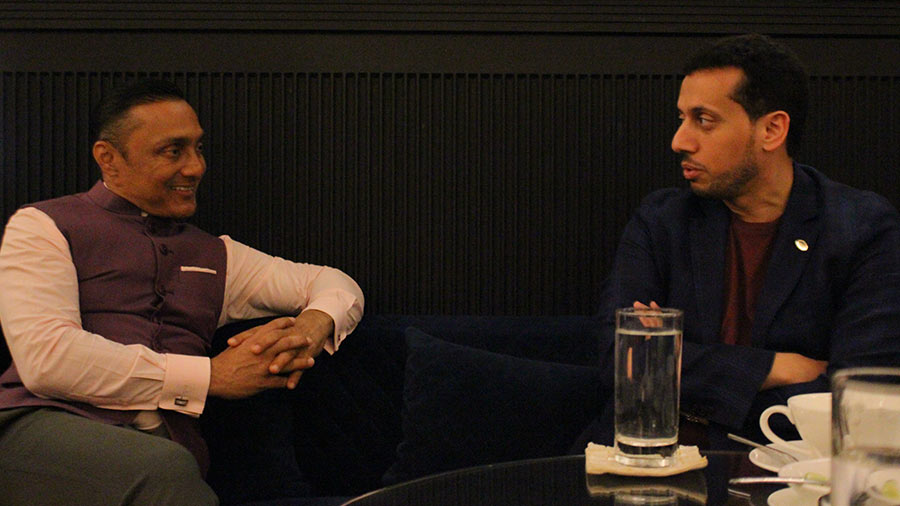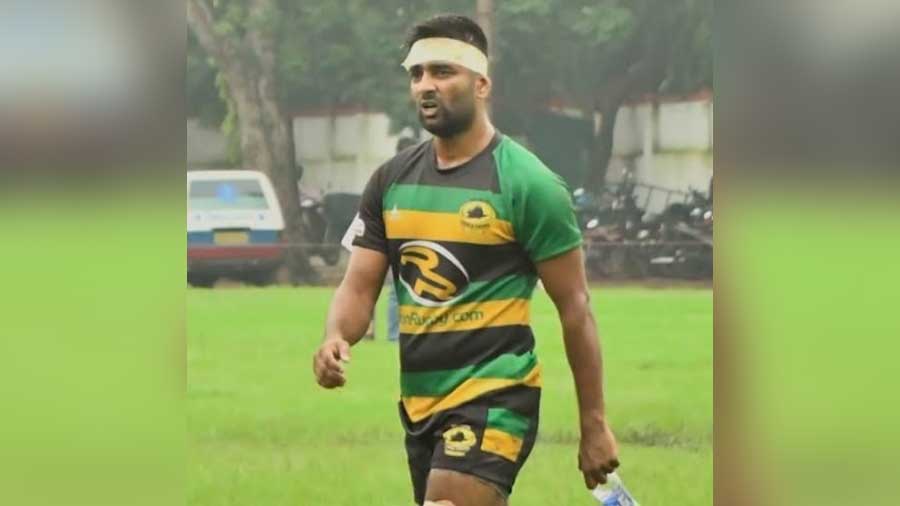More than five million people watched the last edition of the men’s Rugby World Cup in 2019. Even though no Asian nation was involved in the final — South Africa beat England — the tournament was the sport’s first World Cup to be organised in Asia. As hosts, Japan proved that a sport perceived to have a niche following in Europe, Africa and Oceania can capture the public imagination on the world’s biggest continent.
For Rahul Bose, president of the Indian Rugby Football Union (also known as Rugby India), and Qais Al Dhalai, president of Asia Rugby, there is no doubt that rugby can thrive in Asia, including in its second most populous country of India.
Both men were recently in Kolkata to attend the Asia Division Three (South) tournament played at Rabindra Sarobar, which saw India come out on top at the expense of Bangladesh and Nepal. We caught up with Bose and Al Dhalai at The Oberoi Grand to discuss the competition, rugby’s progress in India and Asia, and more.
Edited excerpts from the conversation follow.
What is the importance of the Asia Division Three (South) tournament that India just won? Where does this tournament fit into the larger pyramid of rugby in Asia?
Qais Al Dhalai (hereafter Al Dhalai): There are five sub-regions in Asia. So, ideally, there should be five separate tournaments for the regions. However, due to the pandemic, we combined East, South East and Central for this year together, with South and West running separately. Out of these three events, we already have our winners from East, South East and Central Asia, which is Kazakhstan. Meanwhile, in West Asia, it’s between Qatar and Iran. And here in the South, we now have India. All three winners will face each other in the playoffs in March 2023. India has already expressed an interest in hosting the playoffs. However, as Asia Rugby embraces its guiding principles of Equality, Transparency and Accountability, we’ll have to wait for the consent of the other participating nations before the host nation is confirmed. Why do the playoffs matter? Because the winners get promoted to Asia Rugby Division Two in 2023, and have a better chance of getting involved in the qualification pathway for the men’s Rugby World Cup in 2027, which will be held in Australia.
What did you make of India’s performance? How do you rate their chances in the playoffs?
Rahul Bose (hereafter Bose): India won 82-0 against Bangladesh and beat Nepal 86-0. I felt we were a little cold in the first 15 minutes against Nepal. Against Bangladesh, though, we were switched on right from the get-go. We put down about 25 points in the first 15 minutes, and that set the tempo for the rest of the game.
It’s going to be very tough in the playoffs, since the others are ranked higher than India. But we have three months to work on our game. There are going to be longer camps with more phases, coaching and support staff will be expanded and all arrangements will be made to give India the best possible chance at the playoffs.
‘Asia is the biggest continent in rugby when it comes to youth participation’

Gerald Prabhu, secretary of Rugby India (left), poses with Al Dhalai and Bose displaying the jersey of the Indian rugby team Sourav Nandy
What is your overall assessment of Asia’s position in rugby right now, and how can things improve?
Al Dhalai: Asia is the biggest continent in rugby when it comes to youth participation as well as the overall growth in the sport. But in terms of high performance, Asia is way behind. There are root causes behind Asia’s inability to match up in terms of performance. For starters, rugby isn’t yet a popular sport in the continent. Cricket, football, badminton, even taekwondo, are ahead in most countries. Most players in Asian countries are still amateurs. How can we change the scenario? I think we can look at South America as a role model.
In 2019, South America created the Super Liga Americana de Rugby, which brings together champions from several South American nations to compete in a continental league. It’s the UEFA Champions League equivalent of rugby. That has made a real difference to South American rugby, not least because players now have more matches to play. We all witnessed Chile and Uruguay qualify to the Rugby World Cup 2023 in France to join Argentina. For the first time, three countries from South America qualified for the World Cup, leaving North American giants like the US and Canada out of the scene. That’s exactly what we’re trying to do in Asia, and hopefully we’ll be able to get a franchise-based Super League running here by 2024.
Furthermore, the Asia Rugby Council, at its general meeting in Kyrgyzstan last June, approved the revamped competitions structure, which will witness Asian teams playing 15s-a-side competitions every second year alongside having cross-continental test matches with other regions. This will increase the exposure of Asian teams and give them more visibility on the international stage against teams of similar global ranking levels.
‘We have cut Indian rugby into two horizontals — high performance and grassroots’

India’s U-18 girls after clinching silver last year Rugby India
Could you give us an overview of the state of rugby in India? What are the challenges right now and what progress has been made since you took over as president in December 2021?
Bose: In India, the government policy is to fund Sevens rugby because it’s a medal-winning format in multi-sport events like the Asian Games, the Commonwealth Games and the Olympics. 15s rugby is the Test cricket of rugby, so to speak, as compared to the much shorter version of the Sevens.
Thanks to the performances of our women’s and girls’ teams, we have substantially increased our revenue from sponsors in the last 11 months. The Union Ministry for Youth Affairs and Sport, Societe Generale, Capgemini and the state of Odisha are our four major funders. This is besides the annual grant we receive from World Rugby. We pride ourselves on being very transparent and communicative with our funders. At Rugby India, we believe in taking everybody with us in our efforts to build a world-class ecosystem.
Once the new board took over in December last year, we decided to cut Indian rugby into two horizontals — high performance and grassroots both within the organisation and without. Let’s break that down. What does high performance mean? It means you have to first think audaciously. For instance, our goal is that our women represent India at the Olympics in 2028. (The men face much stiffer competition.) That means we have to be in the top two from Asia.
Now, how do we build from the grassroots? First, we have to remember that rugby is largely a sport played by the urban and rural poor. We have implemented various grassroots interventions, but the real test is: how do we incentivise them to continue with rugby? Here, central and state government incentives play a key role. If you can tell a player (and their family) who is fairly low on the socio-economic ladder that playing rugby could get them a seat in the school in the nearby city, then there’s a good chance that prospect will keep them playing till about 15 or 16. After that, it’s about college and getting a job. Here again the various state sports councils and other government incentives play a decisive role. A seat in a college, maybe even the prospect of a government job can make a difference.
Recently, 18 national and state level players in Odisha were confirmed for government jobs. Then, when players reach 19 or 20, most parents want them to quit the sport, marry and settle down. This is where we want to ask players to come play for their states. The federation's medium-term goal is to pay each and every player that plays for their state. Once they play for India, the target is to give them central contracts.
Apart from these, we have just started work to create a centre of excellence for rugby (the land has been leased) equipped with rehab and sports science facilities as well as coaches, support staff and camps — it must act as a finishing school for the sport in the country. It should be the aspiration of every rugby player in India to be at this centre one day. But this will take at least two or three years to get ready.
We’re also building a programme to identify athletes who have the genetic makeup to play rugby. Don’t tell me we can’t find 50 to 100 such athletes in a country of 1.4 billion people. A franchise-based tournament is also in the works for the past five-and-a-half years. By the end of 2023, it should be in place. We’ve already seen how the franchise model has helped kabaddi. More than 300 districts in India play rugby. If kabaddi, being a sport with contact, thrill and adventure could take off in India, why not rugby?
What have you made of India’s performances over the last year? And what makes our women fare so much better than our men’s teams?
Bose: It’s been a great year post-Covid, but we still have miles to go. This 2022 has been all about gauging where we are with respect to the rest of Asia. As is natural after the years lost to the pandemic. The U-18 girls bagged a silver at the Asia Sevens in September 2021, the U-20s got a silver in Uzbekistan in November and the senior women’s team got a silver medal in Jakarta. The U-20 boys in Uzbekistan were seeded eighth, but finished fourth. They missed out on the bronze, but overperformed. Many boys there will be knocking on the doors of the senior men’s team in a couple of years.
It’s true that our women have a better standard and higher ranking in both Sevens and 15s, as compared to the men. This is because of three reasons. First, the women entered the international arena later, after the men, by which time our systems and structures for the players had improved. Second, high-performing female talent is more concentrated in certain states such as Odisha, Bihar, Haryana, Maharashtra and West Bengal, as opposed to the male talent that is more scattered across the country. Third, the competition in the women’s game, while being strong, isn’t as wide as the men’s, since the men have obviously been playing for much longer across the world.
‘I want to expand the membership of Asia Rugby… that changes the commercial dynamics’

Bose and Al Dhalai in conversation at The Oberoi Grand Sourav Nandy
Mr Al Dhalai, your term as president of Asia Rugby ends in 2024. In the time that remains, what are your most important goals or objectives?
Al Dhalai: I want to expand the membership of Asia Rugby. When my tenure began in November 2019, we had 29 countries. Now, we have 36 countries. I am continuing our massive efforts to gauge interest from governments and National Olympic Committees across Asia, aiming at growing as a family because that changes the commercial dynamics. It’s a big difference having 29 countries as compared to having, say, 40. Second, I want to get one more automatic seat for both men and women from Asia at the Rugby World Cup as I strongly oppose the current unbalanced qualification pathway to the Rugby World Cup. My third objective is to generate more commercial revenue, which is something that requires us collectively to create more opportunities for players, especially after two years of the pandemic.
‘If you want to do it alone in rugby, you can’t. You’ll probably end up in the hospital!’

Rugby exemplifies the spirit of togetherness, feels Bose TT archives
Lastly, Mr Bose, how can popular culture, especially films, help rugby capture the imagination of more Indians?
Bose: A well-made film on rugby, featuring the trials and tribulations of the players and ending in triumph, will definitely be good for the sport. Even documentaries have great potential, because there are so many inspiring real-life stories to be told. Personally, I know at least 20 such stories that can make us all weep with pride. But we need to find the optimal time for popular media to celebrate rugby. It needs to happen when the sport already has a footing and a space in the public imagination, not just in India, but also in Asia. When Chak De! India captured the hearts of one and all, it did so building on a legacy of decades of goodwill generated by hockey. For rugby to have anywhere near the same impact as part of popular culture requires the sport to grow first.
But there’s an enduring reason why rugby will resonate with people once they start watching the sport. It’s because in rugby, like in life, you can only move forward if you do it together. Togetherness is in the bones of the sport. If you want to do it alone in rugby, you can’t. You’ll probably end up in the hospital! The spirit of togetherness is what we carry in everything we do about rugby, too. It’s also the reason why, in spite of shooting five films this year, I feel effortless in giving my time to this sport.


